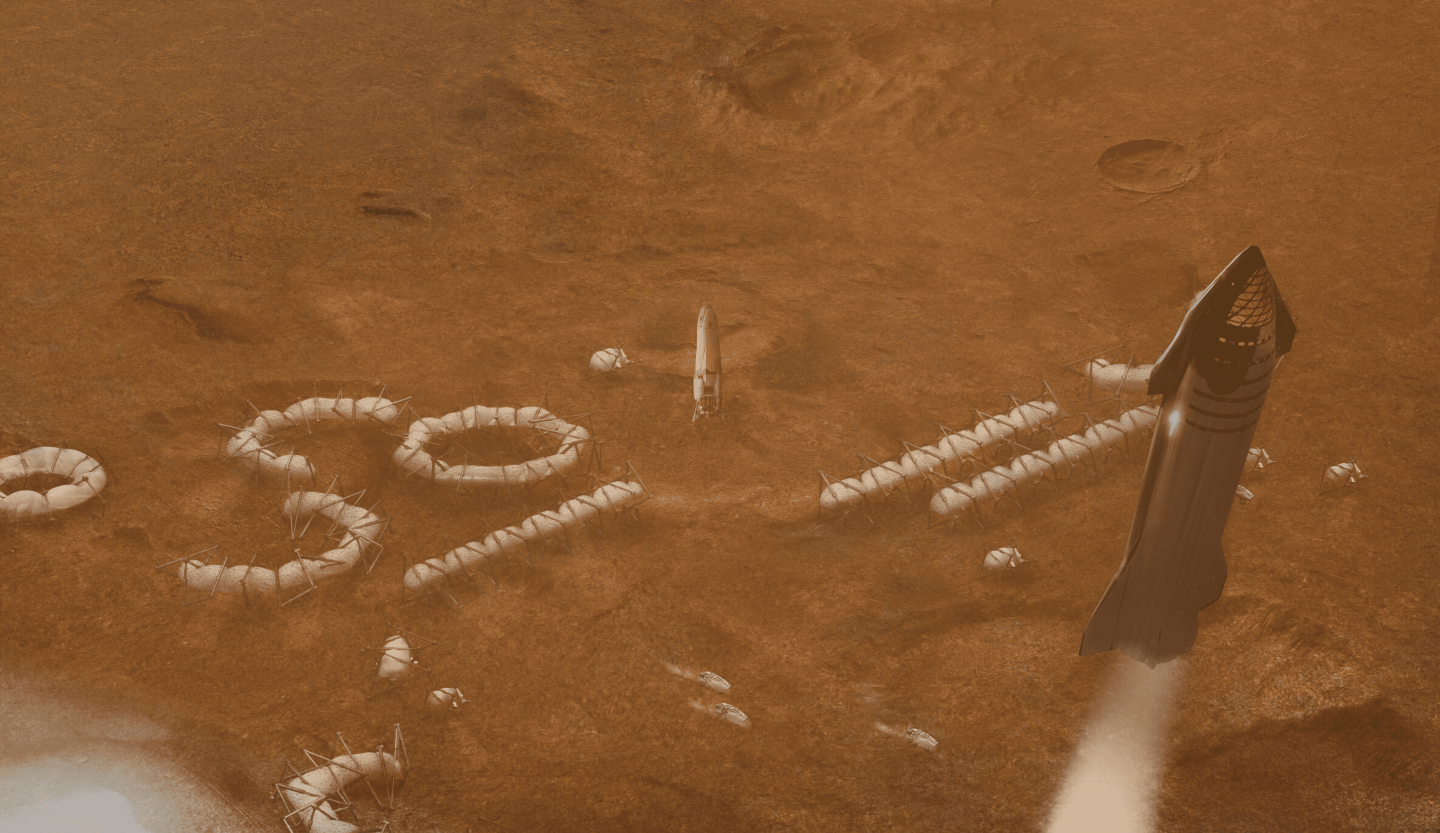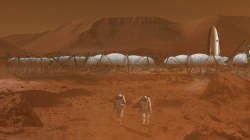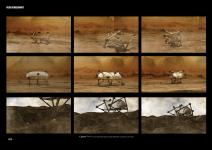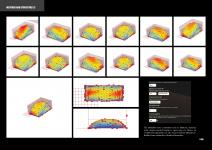POSITION STATEMENT
Human exploration of space is progressing with time and technological development, and it is critical that architects contribute to the design of future habitats on other planets. Existing architectural ideas for Mars overlook a crucial aspect of human settlement: how to guarantee that structures are constructed in the optimal place in such an alien environment. Scientific research has also continuously shown more and more locations with high scientific research potential, but how can we get there? Before settling into a new living environment, architects are obligated to consider how to utilize their expertise in building design and creative architectural construction techniques to boost the viability of future living patterns. Hence, this thesis will discuss how to use architectural form and innovative mechanical systems to create a potential design of a deployable moving Martian architecture that will enable more advanced manned exploration and better comprehend the unfamiliar and unknown environment.
AGENDA
Space architecture, the practice of designing and building inhabited environments in outer space, has started to become a newly emerging subject in architectural studies due to the advancement in technology and the threat of unpredicted disasters on Earth. “Life continuing on Earth is not guaranteed.” 1
Since 2013, NASA has embarked on the visionary of Martian architecture, expecting that this research will open another possible habitat for human beings in the future. According to NASA, the goal of sending humans to Mars is an ongoing study topic that aims to be accomplished in the 2030s. Many well-known architecture studios, such as Foster Partners, BIG, AI Space factory etc., are exploring the possibility of future extraterrestrial architecture from different perspectives such as construction methods, local materials application, supply, and transportation. The challenges that the architect needs to face are not simply design but also construction challenges. The project Marsha designed by the AI space factory aims to use 3d printing to construct structures with local material on Mars. But after consulting with experts who had interviewed the founder of the AI Space factory, this construction method has significant drawbacks. The temperature on Mars is highly volatile. In the process of 3d printing, the printing filament is likely to solidify and shrink prematurely due to temperature changes, thus causing uncontrollable printing form and space tightness. (Image.1) Hence, in the early architectural design phase, on-site construction with direct robots printing technology is unrealistic on such an uncharted terrain during the earliest stage of Mars architectural design. Architects must consider constructing a structure that may be used immediately upon Mars’s arrival.
Besides the climate, the other external factors may also threaten the settlement on Mars. “There is like a new crater forming on Mars every one or two days,” said Ingrid Daubar, a planetary scientist at the Jet Propulsion Laboratory who studies the impacts with the Mars Reconnaissance Orbiter. The craters can be approximately 13 feet wide, which suggests they were formed by objects about the size of a football. Also, according to Johnson. “This is a hazard throughout the solar system that we’ll have to keep in mind as we venture out.”2 Even if the chances of such an event are low, it is a point that is unavoidable for the architect to consider while designing the future habitation.
Access to supplies and scientific investigation will be the primary focus of the astronauts when they arrive on Mars. During the research, scientists constantly update the sites on Mars with potential scientific research values. (image.2) However, there is no guarantee that these potential scientific contributed spots will benefit human habitation on this unknown terrain. Therefore, the architect should contribute more ideas that would support relocating and venturing out to a different location in forms of architecture since it is deadly for people to leave the habitable shelter for an extensive area on Mars without protection. From an architect’s perspective, I argue that the future architecture form on Mars should not be stationary. Instead, it should be in locomotion to provide the best Habitability for the settlers. Since this is an unknown planet, we should consider designing the architecture for this uncharted territory by learning from the early human existence on Earth.
GENERAL SYSTEM OF HUMAN SETTLEMENT
Our race has been historically experienced a lot before human civilization was established. In the book “The Evolution of Human Settlements - From Pleistocene Origins to Anthropocene Prospects,” it was noted that human civilization commenced over 300,000 years ago in the earliest records of anthropologists.3 According to the research, human settlement began about 10,000-5,000 years ago. In other words, for most of the history of humanity, the settlement did not exist. Since humans are conscious and creative organisms, we function in our interaction with the world and the environment around us.
We only create and repeat behaviours that are meaningful to us. Thus for 97% of human presence, using constant mobile habitats is the solution that increases human race survivability in the unforeseen environment. We can examine how clusters are formed through a closed human settlement system. The human settlement requires a systemic environment with inputs (economic, sociological, technological factors and resources from the environment) to produce outputs (built environment, land uses, political and institutional arrangements, a socioecological system, artifacts). In the most primitive environments, the acquisition and development of the inputs is the most critical aspect. Therefore, the human settlement will result from accumulating experience and resources through relocation. At the present phase, the understanding of Mars in terms of the built environment, resource location and treats is not enough to support designing architectures for long-term human settlement according to the settlement system. Hence I think we should use relocatable architecture as one of the driving forces to refine the knowledge about Mars by learning the trajectory of human life before eventual settlement.
Therefore, the emergence of the settlement will result from enhancing the access to Martian knowledge, experience and local resources accumulated throughout the relocation. Therefore, this thesis’s concept and major objectives are to study and explore how to make the buildings move in this unknown land to solve settlement problems such as climate, external factors, and access to supplies, bringing more potential and possibility to Mars habitation.
SITE AND SITE CONDITION
The Mars landscape is a site with complexity, both in resource allocation and climate variability, affecting the site to varying degrees. In terms of composition, size, and surface gravity, Venus is more comparable to Earth. However, considering colonization, time and daily schedule always have a significant impact on the physical and psychological health of the human body. The length of a Martian day is especially close to that of Earth. On Mars, a solar day lasts 24 hours, 39 minutes, and 35.244 seconds”4 which provides a similar 24-hour cycle for human body regulation. According to the article series “What is the Best Planet?”5 In their infancy, Mars and Earth shared similarities with rivers and lakes engraved on their surfaces and volcanoes rising from their plains. Recent observations from NASA’s Mars Design Reference Architecture confirmed the existence of polar caps, which could potentially be the source of water resources. (Image.3) They also demonstrate their investigation into the electrical effects on Mars that could serve as a source of continuous and episodic energy.6 The average acceleration of gravity on Mars is 3.72076 ms-2, which is half that of the Earth. Still, investigations have shown that, unlike the microgravity of the Moon, human lifestyles will not be overly altered or affected by the gravity of -3.72 ms-2.
There are many constraints based on the site’s condition. A proper sustained human presence on Mars requires consideration of many inquiries. Architect should consider how to protect people from the alien, unknown environment of Mars; how to construct, with what material; where to construct, and how to maintain its Habitability through time. According to NASA’s statement, the practice needs to consider four (4) main aspects: Habitability, system development, self-sufficiency, and the physical and psychological impact on habitants’ health.
Habitability - Consider the ability to meet occupant needs with local resources, energy extraction from local resources, and on-site manufacturing and maintenance.
Systems Development - This includes the goal of building reliable and robust space systems that will allow for the gradual and safe growth and expansion of capabilities.
Self-sufficiency - The design increases the level of self-sufficiency for Mars mission operations.
Health - Addresses physical and mental health issues, such as improving bone mineral loss and muscle atrophy in a weight-reduced environment and monitoring emotional and mental conditions. Providing relaxational space.
This thesis will address the four limitations mentioned above by expanding upon a deployable mobile Mars architecture, which will allow for more advanced manned exploration and a better understanding of the site. Relocatable architecture was well-known by Archigram’s “The walking city.” (Image.4) Despite the fact that this is a work of fiction, we can see the architect’s redefining of the placement and mobility of the structure. My definition of architecture is initially a shelter that provides residents with a sense of security, but in the case of war and natural pollution, for example, architecture at a permanent site cannot serve as a shelter. Changing the shape of the structure to one that is mobile is thus one method to revive architecture’s initial essence.
METHODS AND STRUCTURE
As a result of scientists’ ongoing investigation, there are an increasing number of places and resources on Mars that are worthy of study; yet, launching Mars rovers to investigate these regions poses three significant challenges. First, the Mars rover has limited mobility, so if the whole planet is to be explored, more equipment will need to be sent to Mars. This would produce a great deal of space debris and a second issue involving investment funds. A substantial amount of Mars development will be expensive, but also carries the danger of unproductive expenditure. Third, if we want to take people to Mars, the planet’s hostile climate would pose several unknown threats to human life. Therefore, we may create a movable structure that can be studied with its residents on Mars, so expanding the scope of human study and reducing expenditures. In addition, it would passively avoid the danger of some natural calamities to human life.
However, how should the architect design such a structure? What factors must be considered for this design? Which inputs would have the most impact on the design? What experiences were learned from space architecture design that can be applied on Earth?
Goals of the design
1. Structure Move on unflatten tarrain while stablizing on the same horizontal height throughout the trip
2. Simple and Lightweighted Design that can be carry to Mars
3. Simple Moving system
4. External connection to create a cluster of community
5. Habitat have access to the raw terrain for scientific researches
6. Multi-functional spaces
7. Create physical prototyping for the design
URGENCY
This time frame was chosen because the manned mission to Mars is no longer the imaginary science-fiction movie plot. With influential authorities such as Elon Musk, Nasa, and the Chinese national space programme, humankind is one step closer to embarking on a journey to inhabit an extraterrestrial planet. NASA estimates that manned missions to the moon and the establishment of lunar habitats will be completed within the next decade. In addition, NASA is working to build the necessary capabilities to transport people to an asteroid by 2025 and to Mars in the 2030s.11 Billions of dollars have already been invested in researching Mars dwellings in preparation for a human journey to Mars. Thus, I believe that providing a design solution that may benefit human exploration of Mars is an urgent need for architects to design cosmic architecture.
The timeline for this project is dictated by technological advances in the field of space architecture research. I believe that theoretically movable buildings could be deployed to Mars for the initial tests to evaluate the maximum usability and survivability of the project by the 2030s.
Before that, the project could be tested in a similar environment on Earth before 2025. Test whether this machine can move forward smoothly on the unruly ground. It is also necessary to test where the limitation of the design is in order to facilitate the modification. The mobile architecture technology is not only for human exploration of outer space but also may bring a different experience to Earth. If we construct a building that can travel above the Earth’s surface with minimal damage to the local terrain, we can create a dual space that satisfies the desire for human mobility in nature and protects the environment at the same time.
2022
2022
...
Individual Project: Jue Wu
Advisor: Kaicong Wu










